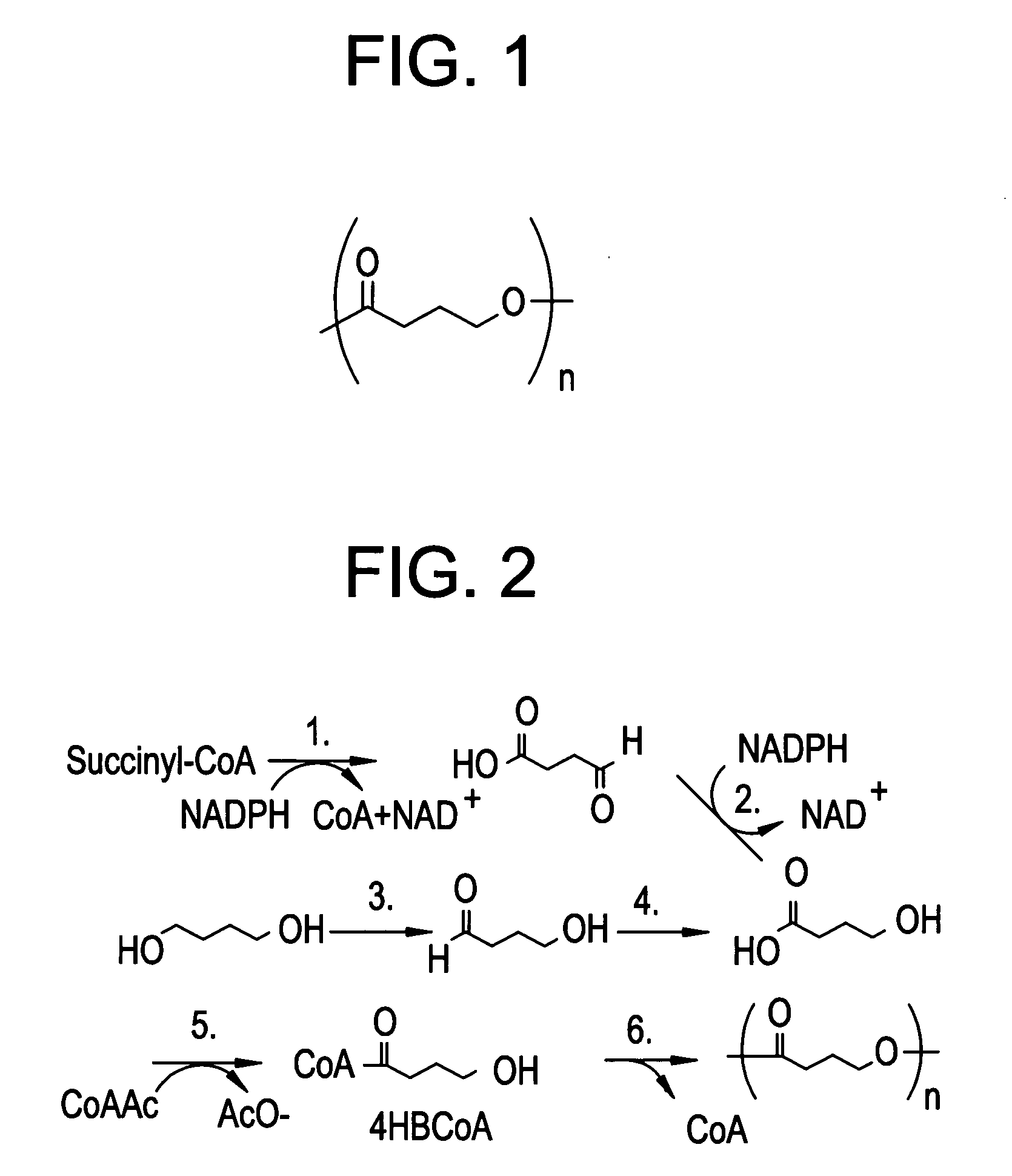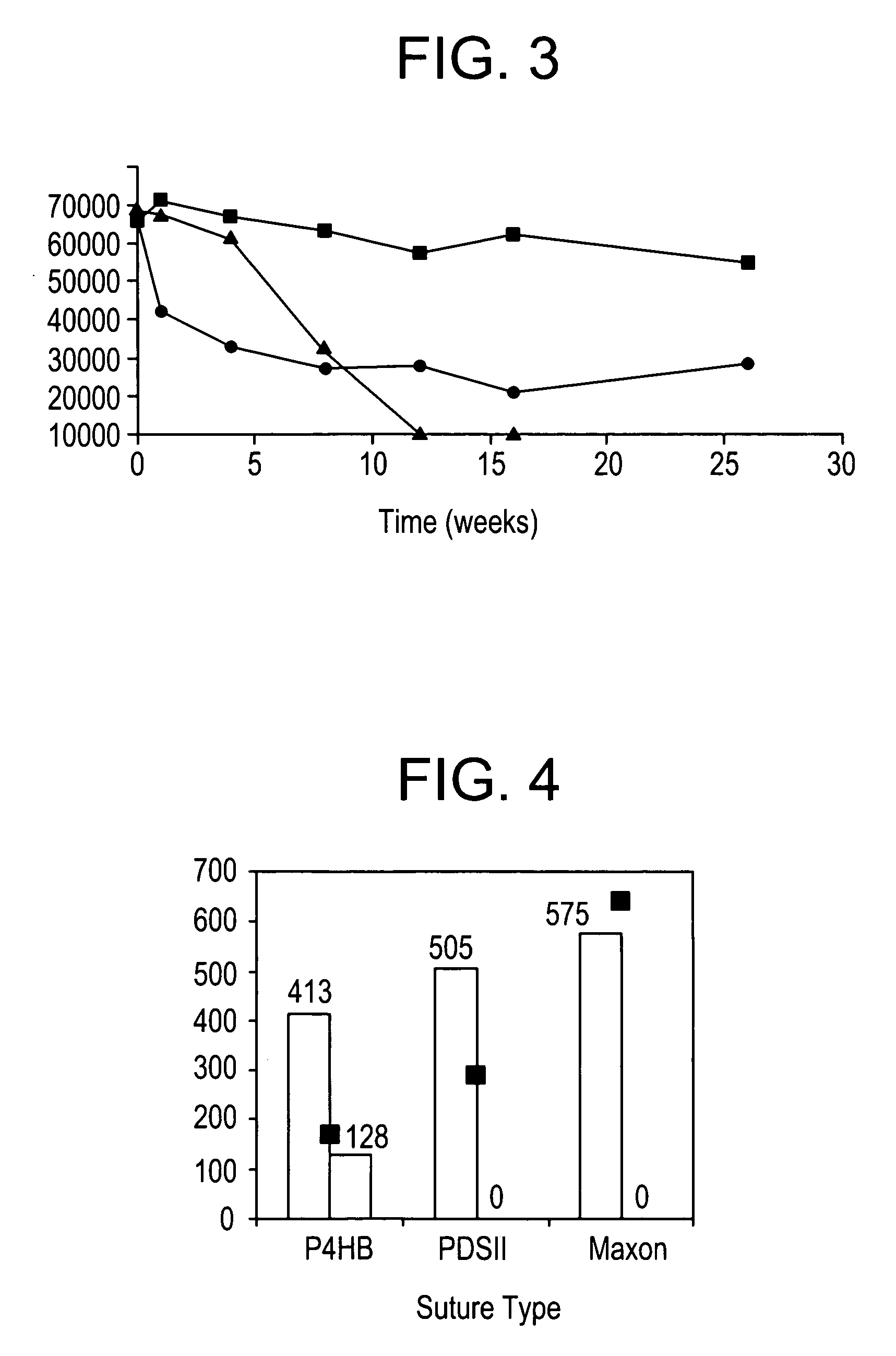Polyhydroxyalkanoate medical textiles and fibers
a technology of polyhydroxyalkanoate and textiles, applied in the field of textile and fiber-based medical devices, can solve the problems of unsatisfactory long-term implantation of non-absorbable meshes, inability to produce polymers with a sufficiently high molecular weight needed for most applications, and restriction of physical capabilities, so as to improve mechanical, biological and handling properties of autologous, allogenic and/or xenogenic tissues, and prolong the effect of strength retention
- Summary
- Abstract
- Description
- Claims
- Application Information
AI Technical Summary
Benefits of technology
Problems solved by technology
Method used
Image
Examples
example 1
Melt Extrusion of PHA4400 to Produce Monofilament Fibers
[0032]PHA4400 (Tepha, Inc., Cambridge, Mass.) (Mw 575K) was ground into small pieces using a Fritsch cutting mill (Pulversette 15, 10 mm bottom sieve) and dried under vacuum overnight prior to melt processing. Monofilament fibers of PHA4400 were melt extruded using an AJA (Alex James Associates, Greer, S.C.) ¾″ single screw extruder (24:1 L:D, 3:1 compression) equipped with a Zenith type metering pump (0.16 cc / rev) and a die with a single hole spinnerette (0.026″, 2:1 L:D). The 4 heating zones of the extruder were set at 140°, 190°, 200° and 205° C. The extruder was set up with a 15 ft drop zone, 48″ air quench zone (10° C.), a guide roll, three winders and a pickup. The fiber was oriented in-line with extrusion by drawing it in a multi-stage process to provide fiber with high tensile strength and a reduced extension to break. The fiber was drawn in-line to stretch ratios of 6 to 11×. A spin finish (Goulston, Lurol PT-6A) was d...
example 2
Strength Retention and Biocompatibility of PHA4400 Monofilament Fibers
[0034]An implantation study to determine the strength retention of PHA4400 fibers was undertaken in a rabbit model. Sample 10 (shown in Table 1) was selected for these studies because the fiber had an elongation to break of 70% and tensile strength of 346 MPa (60,000 psi) that is comparable to commercial monofilament absorbable sutures. Prior to implantation the fiber was sterilized using cold ethylene oxide gas (40° C., ethylene oxide pressure of 13.7 INHGA, humidity of 1.7 INHGA, dwell time 4 hr, and aeration time 10 hr). A small amount of fiber shrinkage (2%) was noted to result during the sterilization process. A commercial monofilament absorbable suture material, PDS™, was used as a control.
[0035]Under sterile conditions, the sterilized sutures were placed perpendicular to the dorsal midline of the rabbit. After making a small incision, a large hemostat was introduced through the incision into the subcutaneou...
example 3
Knitted Mesh of PHA4400 Monofilament Fibers with Prolonged Strength Retention
[0043]A warp knitted mesh of PHA4400 was produced from 100 μm diameter oriented monofilament PHA4400 fiber produced as described in Example 1. A warp knit type of construction is desirable as an implant because it can be cut by the surgeon and will not readily unravel. The mesh was fabricated using fiber of 100 μm monofilament PHA4400, tensile strength 92,000 psi, and an elongation to break of 77%. Fabric construction was as follows: Mach #30 Raschel Knit 36 gauge fabric, 150 ends, 16 courses, 40 stitches per inch, using 18 needles per inch. Specifications for the finished fabric were: Weight: 58 g / m2 (1.72 oz / sq. yard), Thickness: 0.29 mm.
PUM
| Property | Measurement | Unit |
|---|---|---|
| tensile strength | aaaaa | aaaaa |
| elongation to break | aaaaa | aaaaa |
| tensile strength | aaaaa | aaaaa |
Abstract
Description
Claims
Application Information
 Login to View More
Login to View More - R&D
- Intellectual Property
- Life Sciences
- Materials
- Tech Scout
- Unparalleled Data Quality
- Higher Quality Content
- 60% Fewer Hallucinations
Browse by: Latest US Patents, China's latest patents, Technical Efficacy Thesaurus, Application Domain, Technology Topic, Popular Technical Reports.
© 2025 PatSnap. All rights reserved.Legal|Privacy policy|Modern Slavery Act Transparency Statement|Sitemap|About US| Contact US: help@patsnap.com



